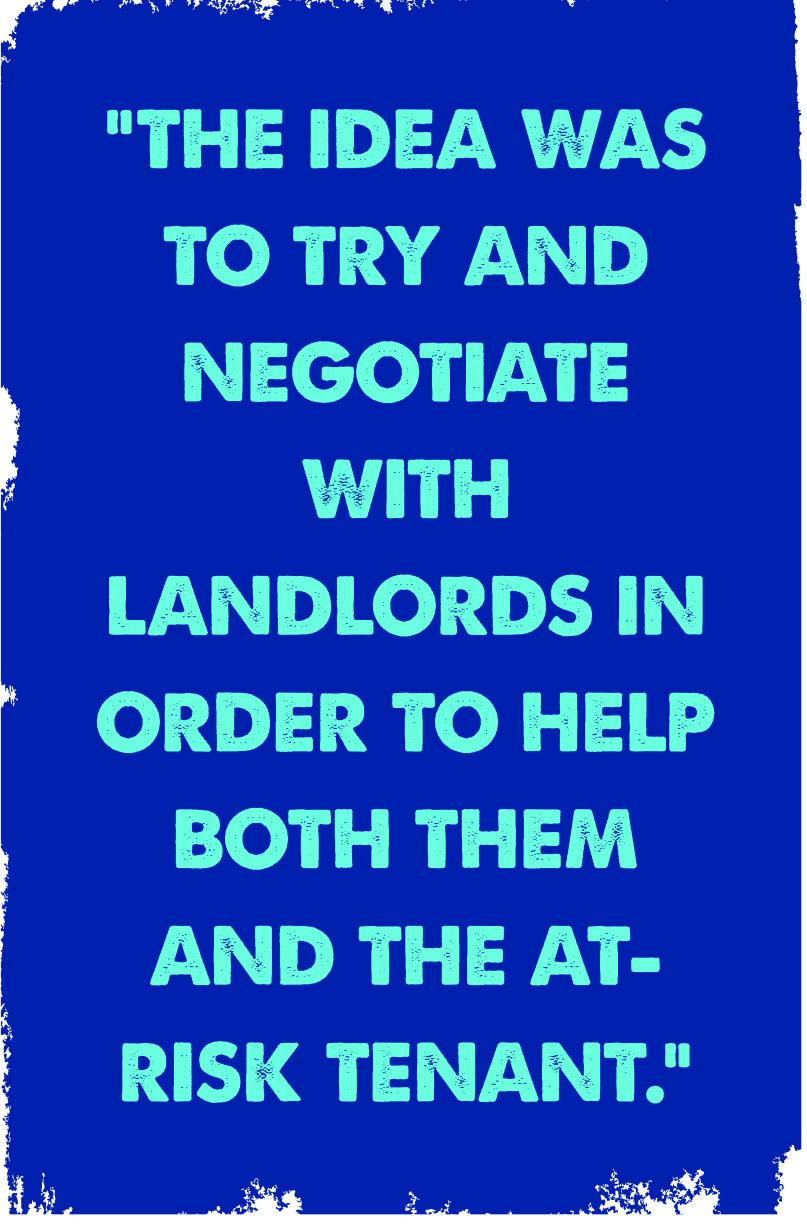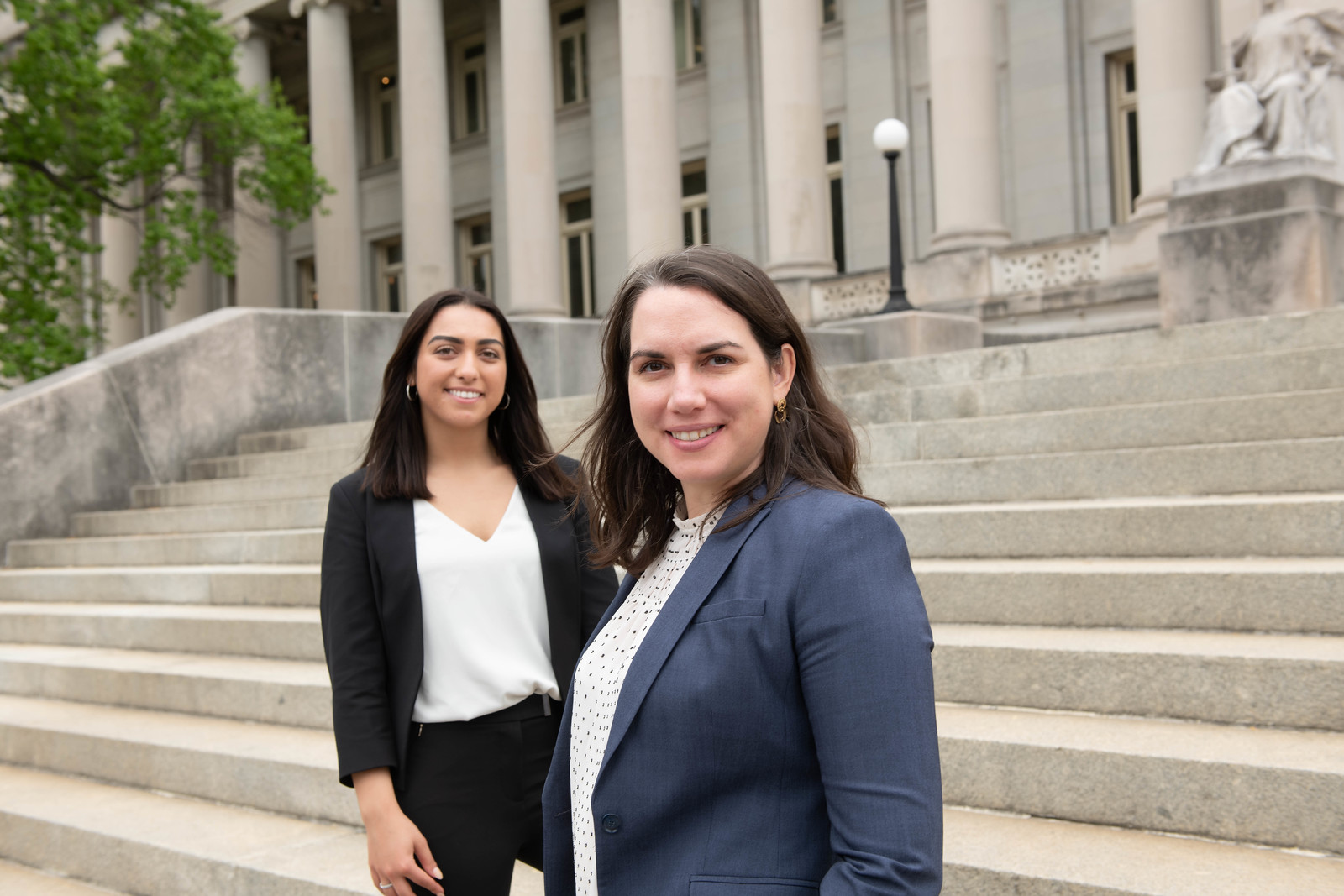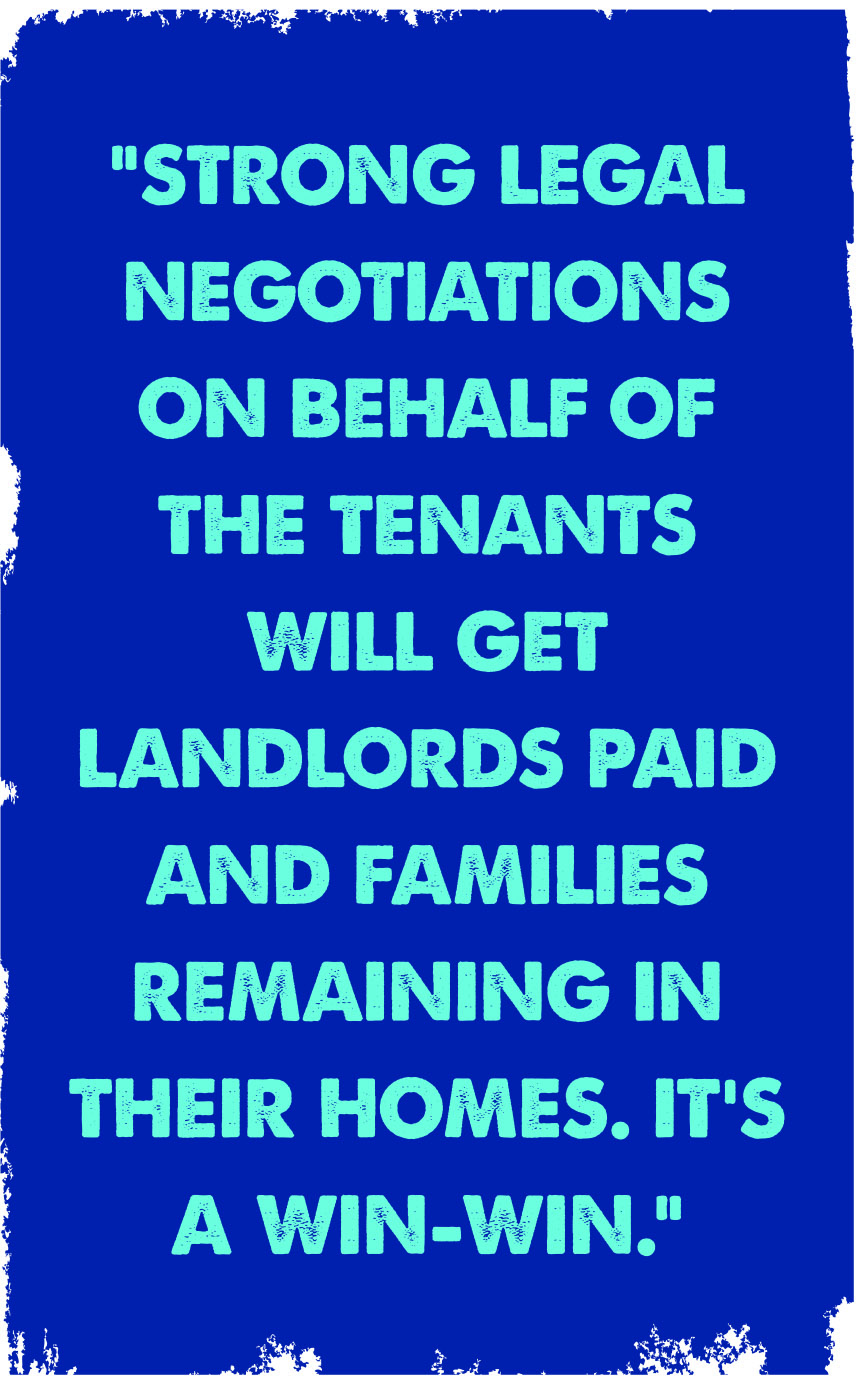School of Law
HOUSING ON HOLD
By Ryan Jones
OVER THE PAST YEAR, THE COVID-19 PANDEMIC HAS LEFT A MARK ON CITIZENS across the country, but its most detrimental effects have been felt by some of the nation’s most vulnerable segments. With many individuals struggling to pay their bills due to loss of work or new health concerns, the pandemic has resulted in a new threat to not only their economic livelihood but also their homes. Large segments of the population, many of them low-income people of color, were faced with the threat of eviction at a time when they have also been more at-risk for infection, hospitalization, death and income loss, all as a result of the COVID-19 pandemic.
HOW DID WE GET HERE?
A national moratorium on evicting tenants from certain residential and rental properties went into effect as part of the first COVID-19 relief package, the Coronavirus Aid, Relief, and Economic Security (CARES) Act, that former President Donald Trump signed in March 2020. That moratorium protected about 28% of U.S. rental units — roughly 12 million, according to analysis from the nonprofit organization Urban Institute — and included properties backed by federal mortgage loans and federal housing programs. Tenants were not exempt from paying rent, as bills piled up on those who couldn’t pay, but evictions dropped considerably, and the moratorium prevented millions of individuals from losing their homes during the pandemic, according to a ProPublica analysis of court records from more than a dozen states. However, that moratorium expired at the end of July 2020, so as a public health measure, the U.S. Centers for Disease Control and Prevention (CDC) halted evictions for nonpayment of rent about two months later in September 2020.
As a result of this crisis, a group of law students, professors, attorneys and local government offices in Memphis and Shelby County came together last summer to form a program intended to help both tenants and landlords affected by COVID-19. The Eviction Settlement Program (ESP) was formed to help connect attorneys with tenants in danger of eviction due to financial hardships associated with the COVID-19 pandemic. Managed by Neighborhood Preservation, Inc., the University of Memphis School of Law, Memphis Area Legal Services, the City of Memphis Division of Housing & Community Development and Shelby County Community Services, the program originally oversaw approximately $2 million in emergency financial assistance through the federal CARES Act.
It was an innovative partnership, one that differed from other cities across the country attempting to allocate CARES money to landlords and tenants, and it continues to evolve as the pandemic and associated eviction moratoriums drag on.
A 'CARE-ING' PARTNERSHIP - EVICTION SETTLEMENT PROGRAM PART 1
Steve Barlow, a Memphis Law adjunct professor, co-director of our Neighborhood Preservation Clinic, and president and co-founder of Neighborhood Preservation, Inc., was the impetus behind the formation of the program. Alongside Memphis attorney Webb Brewer, Katy Ramsey Mason, assistant professor of law and director of the law school's Medical-Legal Partnership Clinic, and Danny Schaffzin, law school director of experiential learning and associate professor of law, Barlow and company started to develop the idea not long after the passage of the CARES Act in March 2020. They saw other cities across the nation setting up programs that utilized a first-come, first-served approach to issuing grants directly to homeowners or renters, but after seeing how quickly money became depleted and how inequitable distribution was under this model, they devised the plan that would eventually become the Eviction Settlement Program.

“The idea was to try and negotiate with landlords in order to help both them and the at-risk tenant,” said professor Schaffzin. “We wanted to make it more of a legal representation program with the backing of this fund created by the city and county offices involved.”
Early on, this team and several others approached local government and public officials for their assistance in organizing the program. They found a sibling powerhouse to assist their efforts in the form of Paul Young, director of the City of Memphis Division of Housing & Community Development, and his sister, Dorcas Young Griffin, director of Shelby County Community Services.
“We knew from the start of this pandemic that significant impact would be felt on both the health and economic fronts for Shelby County residents,” said Griffin. “Keeping every family in their home is top priority.” Young also saw the importance of making sure no families were turned out of their homes due to financial burdens associated with the pandemic.
“Housing insecurity in this community is a serious issue,” he told the Tri-State Defender. “This potential displacement of individuals and families is devastating. Those who could least afford it have had to suffer the effect of the shutdown, job loss and dealing with the illness itself.”
After learning of $2 million in CARES Act funds being allocated to the city and county,
Young and Griffin worked with Barlow and his team, as well as Memphis Area Legal Services,
the University of Memphis
School of Law, Innovate Memphis, General Sessions Civil Court and a number of other
local agencies, to put together and formally launch the Eviction Settlement Program,
giving tenants legal and financial support, but also long-term financial counseling
and social services to help decrease the chances of future eviction.
The tenants are not the only ones the program was intended to benefit though. Landlords have also been hurt throughout this pandemic, and the ESP recognized that.
“We are counting on the compassion of the landlords who need payment but realize that the effects of the pandemic have been hard on everyone,” said Young. “Strong legal negotiations on behalf of the tenants will get landlords paid and families remaining in their homes. It’s a win-win.”
Brewer echoed that sentiment in a statement to the Tennessee Administrative Office
of the Courts. “Because landlords were hurting too from this, and part of our belief
was that a tenant in-hand, especially if they had been a reasonably good tenant before
the crisis, was better than the unknown, which might be not being able to rent the
place.” 
These tenants and landlord applicants were first screened through an online portal before being referred out through either the law school’s legal clinic or through Memphis Area Legal Services. The clients were then put in touch with their attorneys, which could be a private volunteer lawyer or a law school professor or student who would then discuss possible resolutions with the client. All agreements were conditioned on the tenant being able to continue residence in the property they were renting at the time, with landlords also making a mandatory promise to make any necessary repairs and maintain the property in habitable condition.
The partnerships that enabled this program to come to fruition were also a big reason for its success, according to another Memphis Law professor that was vital to its development since the beginning.
“I think this program only worked because we had lawyers on the tenant’s side,” said assistant professor and director of the law school’s Medical-Legal Partnership Clinic Katy Ramsey Mason. “If you think about having a non-lawyer or the tenant themselves trying to negotiate settlement agreements with the landlord and request the types of protections we got for our clients, that is just not possible without an attorney. It’s the difference-maker in what made this successful.”
As an example of that need for legal services, a recent congressionally mandated study by the Legal Services Corporation found that only 1.3% of Shelby County’s eviction cases from 2016–19 resulted in a clear ruling for the tenant. That is particularly concerning, yet not unpredictable, given that an estimated 95% of tenants don’t have a legal advocate by their side.
The need for more legal assistance was clear to the program planners.

Professors Schaffzin and Ramsey Mason took the lead on recruiting law students for the program and both saw it as an ideal learning opportunity for students to get meaningful experience in a timely area of public concern, with the chance to make an immediate difference in a client’s life.
More than 20 students took part over the summer and fall as part of the program, doing a variety of work as the need arose. From calling clients to gather additional information about their situation or going to get paperwork from court, to speaking with landlords’ attorneys to get conversations started about settlements, the learning that continues to occur as part of the program ranged far and wide.
One Memphis Law student who took up the mantle to serve through this program even found himself as the recipient of the Law Student Volunteer of the Year Award from the Tennessee Bar Association (TBA).
 Memphis Law 2L Gerald Bradner received the annual award in 2021 for providing outstanding
volunteer services while working with an organization that provides legal representation
to the indigent, all as part of his work with the Eviction Settlement Program.
Memphis Law 2L Gerald Bradner received the annual award in 2021 for providing outstanding
volunteer services while working with an organization that provides legal representation
to the indigent, all as part of his work with the Eviction Settlement Program.
When Schaffzin and Ramsey Mason asked for volunteers to help meet the heavy demands of the program, Bradner eagerly stepped up. He took on dozens of cases over the first few months of the program, reviewing paperwork, meeting with tenants and landlords and negotiating settlements, all under the supervision of his attorney mentor and ESP participant, Monique Beals (JD ’88), who practiced most recently with Bass, Berry & Sims PLC and Baker Donelson prior to that.
“During my career, I have never met a law student like Gerald,” said Beals in her nomination letter to TBA for the award. “His eagerness to help, his willingness to take the initiative, his refusal to take no for an answer to benefit his clients and his communication skills are unparalleled even by the standards of practicing attorneys.”
Bradner was no stranger to serving. He enlisted in the Army after high school and was soon sent to Iraq, a focal point of the Al-Qaeda insurgency at the time. He was deployed there for 15 months, and after showing a great deal of leadership ability, was accepted into the Army’s officer training program. He soon found himself at James Madison University, where he earned a degree in justice studies and studies before being commissioned as an intelligence officer and being deployed to Kandahar, Afghanistan’s second-largest city.
While he found his time in the Middle East rewarding and important, he soon found himself considering a second career after his stateside staff assignments. This led to him looking for a career that he found as honorable as his time serving in the Army, and he soon enrolled at Memphis Law. It wasn’t too long before he enthusiastically accepted professor Schaffzin’s call for student volunteers with the ESP and began to work on the types of cases that would result in him receiving the prestigious Law Student Volunteer of the Year Award.
“One client was a certified nursing assistant who had three children and worked in a COVID ward,” Bradner told the TBA in an article about his award. “She was so happy when she found out she had someone in her corner that she dissolved into tears.”
In that case, Bradner discovered that there were close to 30 tenants at the same complex facing eviction. He remembered that Barlow had recently piloted a bulk settlement concept in a similar situation, so he went to him to see if it might work in this case. After getting the green light, he developed a proposal, met with the tenants and successfully negotiated a deal with the landlord and his counsel, keeping most of the tenants from being evicted.
Bradner found it satisfying to reach the settlement in that case and others, and found
“amazing” the amount of support and guidance he received from Beals and the law school’s
Clinical Program and faculty. “If I can do something like that every year of my career,
then I’ll have a very long and satisfying career,” he said. The program was considered
an overwhelming success. It ran until federal funds ran out shortly before the new
year, handing out approximately $2 million in aid to local
tenants and landlords in need throughout the course of the summer and fall. But eviction
moratoriums were (and are) constantly under threat of expiring or being overturned,
and the pandemic was still raging when the program ended.
So what happened next?
More Money (for) More Problems – Eviction Settlement Program Part II and Beyond
With more than 26,000 eviction notices filed locally in 2019 alone, and 10,000 additional notices filed in Shelby County in the final six months of 2020, the eviction issue in Memphis was not solved overnight, despite the successful first round of the Eviction Settlement Program.
Earlier this year, President Biden extended the CDC’s eviction moratorium through March, though that was seen as only a stopgap measure. It was subsequently extended through July 31 at the federal level after several court battles, including a recent decision by the U.S. Supreme Court.
Additionally, more federal aid was confirmed in the spring with Congress’s passage of the $1.9 trillion stimulus package in March, with Memphis and Shelby County allocated approximately $30 million in emergency rental and utility assistance.
That $30 million in funding was utilized for eviction relief through the eviction settlement fund, allowing the Eviction Settlement Program to continue its successful work from the fall. But the leaders of the ESP here in Memphis had to adapt to rapidly changing conditions, often in real time.
“We are literally building the airplane as we are flying it with this new money,” Griffin said at the time. “It’s a historic amount of money. We have never received this kind of money for this kind of service in our community at one time, ever.”
One item that evolved as a result of the ESP’s successful fall implementation was the use of “equitable randomized selection.” This new, weighted selection process set a standard for future programs in local government that have traditionally been decided by the “first-come, first-served” approach of who gets in line first or who submits their paperwork first.
“We are giving weight to applicants who meet certain criteria – those that are elderly, that are veterans, may have disabilities and are at 50% or below of the poverty rate. Those are the ones we are adding more weight to,” said Young, of City Housing and Community Development in an interview with the Daily Memphian.
“Those that have urgent needs or those that are facing eviction or those who are having utility cutoffs – those individuals and households will be pulled out of that selection process and immediately get help they need, as long as they meet our program criteria.”
The economic dislocation caused by the pandemic has already resulted in thousands of Memphis-area renters falling behind and made clear the need for the ESPs continued implementation.
However, numerous locations across the country started to challenge the CDCs authority to issue the ban on evictions.
Notably, for Shelby County and nationally, United States District Judge Mark Norris, ruled in March that the government overstepped its bounds when it put a moratorium on evictions last year. In his ruling, Judge Norris said the government’s order is unenforceable in West Tennessee.
The decision came just two weeks before the federal ban on evictions was initially set to expire, which is a key item to note according to attorneys involved with the Eviction Settlement Program. They had planned to use that remaining time to work on applications submitted to the ESP.
MALS CEO and ESP partner Cindy Ettingoff said that 68% of the people they’ve helped through the program had no issues paying rent before the pandemic but now struggle to do so after losing their job.
Regardless of the recent decisions regarding moratoriums, many ESP partners are optimistic that many landlords and tenants will still work with the program, especially landlords that are looking to recoup as much money as possible.
But with no local moratorium in place, the program lost a lot of its leverage.
 “I think in some cases a landlord could see 80, 90, or even in some cases 100% of
the back rent owed if they work with the Eviction Settlement Program,” said professor
Schaffzin. “If they choose to evict the tenant, they are not going to see any of that
money. They know they will not be able to collect money from the majority of those
tenants, so it’s in their own interest to not evict the tenant and to work with us.
“I think in some cases a landlord could see 80, 90, or even in some cases 100% of
the back rent owed if they work with the Eviction Settlement Program,” said professor
Schaffzin. “If they choose to evict the tenant, they are not going to see any of that
money. They know they will not be able to collect money from the majority of those
tenants, so it’s in their own interest to not evict the tenant and to work with us.
“The leverage for our program now is the amount of money people owe and the availability of money to get to landlords to keep tenants in place. We have around $25-30 million right now for that and that’s not a small amount of money. There’s utility assistance, future rent, and more that this money can be used for.”
Other states around the country have put in place a number of rental assistance programs and even extended their local moratoriums several months past the CDC’s end-of-July cutoff. Additionally, New York, Washington, California and more than a dozen cities, have implemented right-to-counsel programs to ensure that tenants in those locations have the opportunity to look for assistance before they are evicted.
Most notably, California recently passed a bill that gave landlords rent debt relief and required owners to seek rental assistance and give any applicable tenants the opportunity to seek help before eviction proceedings begin.
But are these patchwork solutions the best available route? Or should advocates hope for another moratorium extension? Are federal rental relief funds being used as best as they could be throughout the country?
“I don’t think it would be inappropriate for the moratorium to be extended again, especially given the Delta variant surge we are seeing nationally,” said professor Ramsey Mason. “However, the moratorium has never been intended to be a permanent solution, and eventually we have to move past it. Eviction diversion programs, especially those that mandate pre-filing mediation for nonpayment evictions, are highly effective.”
Some locales, such as those mentioned above, as well as notable programs in Philadelphia and Michigan, have shown great success in their efforts to help those in need get relief and in the dispersant of federal aid.
However, states like Wyoming and nearby Mississippi have only spent a very small amount of their federal government rent assistance funds – 1- 3% respectively. More than two dozen states, including those two, have no statewide eviction moratoriums in place, as of this writing.
The data does seem to suggest that, nationally, renter debt is trending down, but there are still millions of tenants with rental debts. According to an analysis by National Equity Atlas, a group that studies social equity among states and cities with data from the U.S. Census Bureau, nearly 6 million households are behind on rent, amounting to $20 million in rent debt. That is indeed down from approximately 17 million households last summer, but the majority of those citizens still affected are people of color, at 66%, and low-income households, at 81%, which are those making less than $50,000 a year, according to the data from the National Equity Atlas group.
The vast majority of the nearly $50 billion that Congress allocated for rental assistance has not been spent as of this writing, and in areas, such as the nearby state of Mississippi, there are glaring racial disparities in who is receiving aid because of a lack of awareness about the programs and a basic bureaucracy that is prohibitive to these populations taking advantage of the programs themselves.
The Biden administration worried about a rush of evictions occurring with the moratorium's
end and encouraged communities to adopt a variety of related efforts before the moratorium
itself is lifted.
Gene Sperling, senior advisor in the Biden administration noted that the country was in a race against time, with emergency rental aid slowly trickling out.
“We are asking for states and local governments to do everything they can to fill that void in a hurry,” Sperling told NBC News this summer.
Mason also agreed that the lifting of the moratorium places a large number of renters at risk and that time is of the essence to make best use of these federal aid dollars.
“The lifting of the moratorium will make a big difference across the country,” said Mason. “There are millions of people who would have qualified for the protections of the CDC’s order, and most jurisdictions don’t have any additional protections in place at this point. That being said, there are billions of dollars of federal funds that are intended to be used to keep tenants housed, and all state and local governments have access to those.”
Locally, Memphis has not had to worry as much about the July 31 end-date, due to Judge Norris’ ruling in March negating the moratorium in the Western District of Tennessee. But regardless of how things have continued to play out this fall, the success of the Eviction Settlement Program is one to applaud.
“There’s been concern on the national level about the slow pace of distributing these funds, but fortunately that’s not an issue for us here – our program has been steadily churning out funds since March,” said Mason. “As of now, we’re approaching $15 million in assistance that’s been distributed for rent and utilities in Shelby County.”
This relief provided through the ESP has kept more than 1,200 households from losing their homes so far. But of course, the need is far greater. It’s clear that innovative programs like the Eviction Settlement Program are needed to defend against the public health and housing crisis that eviction perpetuates, and as Memphis takes the national spotlight in the eviction crisis, the team of law students, attorneys, government officials, and law school professors behind the Eviction Settlement Program seems well-prepared to continue to help our most vulnerable citizens.

